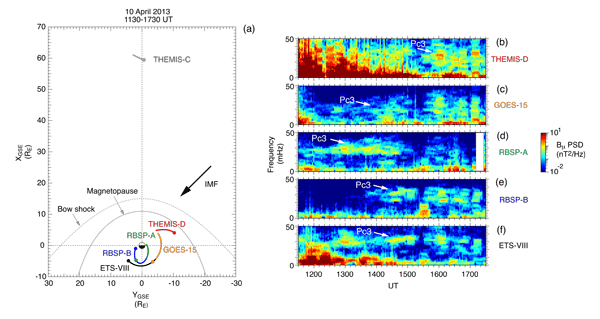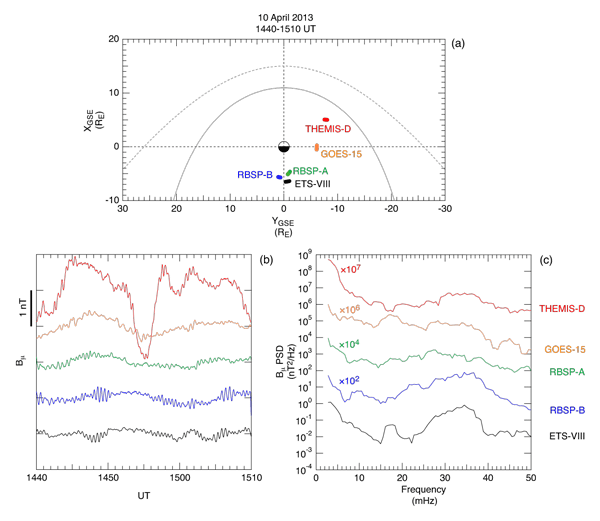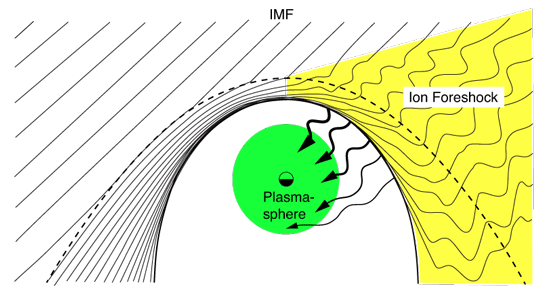
2016 THEMIS SCIENCE NUGGETS
Propagation of upstream ULF waves to the midnight region of the magnetosphere
by Kazue Takahashi
Johns Hopkins Applied Physics Laboratory
Introduction
ULF waves are generated through the interaction of ions traveling sunward from the bow shock with the incoming solar wind. The waves, called upstream ULF waves, occupy a region called the ion foreshock, propagate into the magnetosphere, and produce magnetic field oscillation known as Pc3 waves (frequency = 22-100 mHz). The waves are intrinsically compressional and are capable of propagating across the background magnetic field to the inner magnetosphere. The waves even propagate to the ground and are routinely detected by magnetometers located at low latitudes. This wave phenomenon was intensively studied in the early days of magnetospheric research and remains to be an important research topic in relation to the physical processes occurring around the bow shock. Historically, reports of Pc3 waves of upstream origin have been limited to the day side. However, a recent study demonstrates that the waves can propagate over long distances to the night side.
| Figure 1. (a) Locations of six spacecraft during the 6-hour period studied, mapped to the equatorial plane of the Geocentric Solar Ecliptic coordinates. The heavy dots indicate the stating locations. (b-f) Dynamic spectra of the compressional component of the magnetic field measured by the five spacecraft located in the magnetosphere. |
Results
Figure 1 shows an example of global Pc3 waves detected by multiple spacecraft. The THEMIS-C spacecraft was located in the solar wind and observed that the interplanetary magnetic field (IMF) was directed along the black arrow shown in Figure 1a. With this IMF orientation, the ion foreshock should be formed on the morning side, and upstream ULF waves are expected to enter the magnetosphere through the morning-side magnetopause. THEMIS-D and GOES-15 were in good positions to confirm this expectation.
Figures 1b-1f show the dynamic spectra of the compressional component of the magnetic field at five spacecraft, which were located in the equatorial region of the magnetosphere. All spectra indicate an enhancement of wave power at ~30 mHz (labeled "Pc3") with similar intensity modulations occurring over a wide range of local times including the midnight sector. Particularly impressive are the spectra at RBSP (Van Allen Probes)-B and ETS-VIII, which indicate nearly identical Pc3 waves from 1430 to 1720 UT, a time period when the spacecraft were located in the midnight sector. The wave intensity at midnight is weaker than that observed in the prenoon sector by THEMIS-D but does not differ much from that observed at dawn by GOES-15.
| Figure 2. (a) Spacecraft locations for a selected 30-min interval. (b) Time series plots of the compressional components of the magnetic field at the spacecraft. (c) Power spectra computed from the time series data. |
Details of the Pc3 waves are shown in Figure 2 for a 30-min interval. Three spacecraft, RBSP-A, RBSP-B, and ETS-VIII were near midnight (Figure 2a) and detected compressional magnetic field oscillations with a considerable amplitude modulation (Figure 2b). The amplitude of the oscillation is only a fraction of 1 nT, but the oscillations stand out both in the time series plots and power spectra (see the broad enhancement at 25-40 mHz, Figure 2c). We conclude that the oscillations are of dayside origin because there were no other notable disturbances such as Pi2 pulsations, which are generated on the nightside in associated with auroral activities. At THEMIS-D, Pc3 waves were also present on top of large amplitude slow oscillations that are attributed to variations of the solar wind dynamic pressure. Cross correlation analysis of data from RBSP-A, RBSP-B, and ETS-VIII indicates that the waves were propagating from dawn to dusk with a phase speed of ~300 km/s, a value consistent with the velocity of magnetohydrodynamic (MHD) fast mode waves estimated from the measured local magnetic field and plasma density.
Conclusion
Figure 3 illustrates our interpretation of the observations. The ion foreshock (shown in yellow) was formed on the morning side where upstream waves were generated. The waves have a phase velocity lower than the solar wind velocity. As a consequence, the waves propagate toward the Earth in the Earth frame of reference, passing through the magnetosheath and impacting the magnetopause. From the magnetopause, the waves propagate inward as MHD fast mode waves with wavelength comparable to those of the wavy lines with arrowheads. When the magnetosphere is not very active, the waves are not masked by other disturbances and produce small-amplitude but clear oscillations in magnetic field data. It is important to note that RBSP-A and RBSP-B were located in the dense plasma region (the plasmasphere, shown in green). Apparently, the plasmapause does not shield the waves.
| Figure 3. Schematic illustration of generation of ULF waves in the ion foreshock and their propagation into the magnetosphere. |
The illustration is for concept only. We speculate that the waves may be focused or diffracted as they propagate in the inhomogeneous magnetospheric plasma. More case studies and statistical analyses of the spatial distribution of Pc3 amplitude and their comparison with global numerical simulations of ULF wave propagation will be an interesting extension to the case study described here. We conclude that availability of data from multiple well-instrumented spacecraft allows us to gain new insight into well-known wave phenomena.
Reference
K. Takahashi et al. (2016), Takahashi, K., M. D. Hartinger, D. M. Malaspina, C. W. Smith, K. Koga, H. J. Singer, D. Frühauff, D. G. Baishev, A. V. Moiseev, and A. Yoshikawa (2016), Propagation of ULF waves from the upstream region to the midnight sector of the inner magnetosphere, Journal of Geophysical Research: Space Physics, 121, doi:10.1002/2016ja022958.Biographical Note
Kazue Takahashi is a member of the professional staff at The Johns Hopkins University Applied Physics Laboratory. He has studied magnetospheric ULF waves using observations from various spacecraft, including AMPTE/CCE operated from 1984 to 1989 and the currently active THEMIS and RBSP/VAP.
 Please send comments/suggestions to
Emmanuel Masongsong / emasongsong @ igpp.ucla.edu
Please send comments/suggestions to
Emmanuel Masongsong / emasongsong @ igpp.ucla.edu



